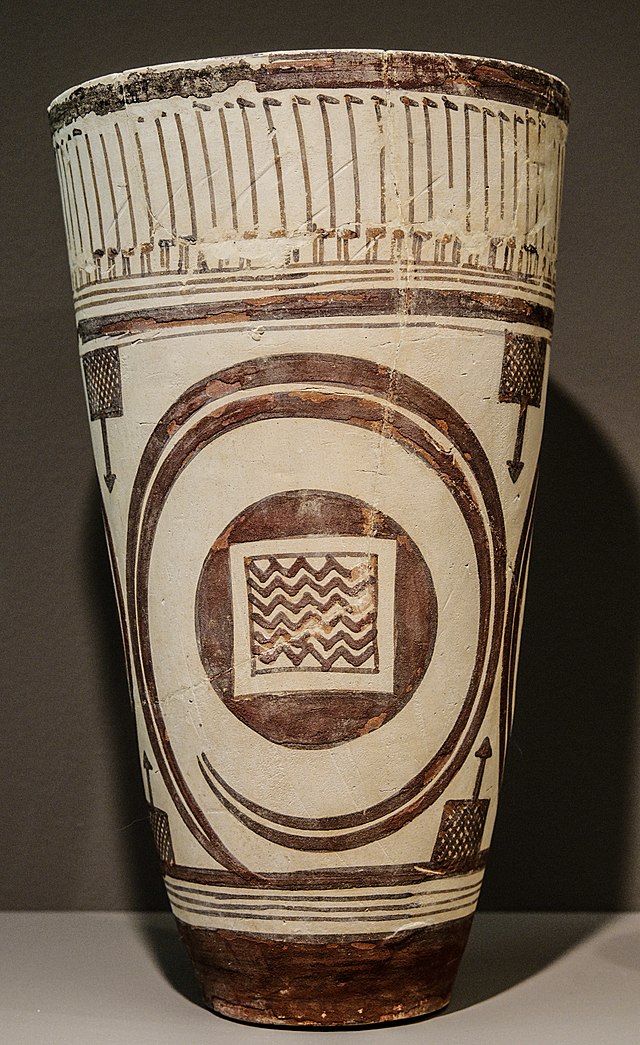Global Prehistory
1/11
Earn XP
Description and Tags
I'm so tired
Name | Mastery | Learn | Test | Matching | Spaced |
|---|
No study sessions yet.
12 Terms
Running Horned Woman. Tassili n’Ajjar, Algeria. Pigment on Rock. 6000-4000 BCE.
Context: neolithic and depicting ritual bc of body paint/horn on head. Could be a goddess bc is the central figure and painted body. Could be running or dancing. The rock is painted and found in a secluded place suggesting its location was a sanctuary.
Function: agricultural aspect bc there is grain falling near the head.
Content: fertility aspect from exaggerated breasts.
Form: very stylized. Many ppl surround her marking her importance to others
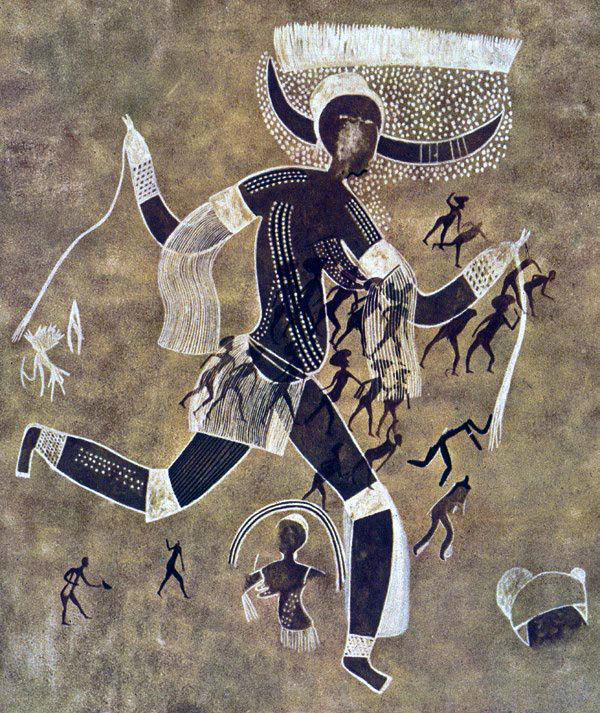
Jade Cong. Carved jade. Liangzhu, China. 3300-2200 BCE.
Form: carved jade, fits in palm, square cross-section/circular hole, face pattern across the corners (male figure/beast). Too hard to carve, so instead it is abraded (worn down w friction), very heavy
Function: laid around deceased bodies in a circle, symbol of wealth and social status, given as gifts. Probably connected to the burial of the privileged
Context: neolithic (farming is happening, ppl settled down)
Content: face pattern can refer to spirits/deities and possible supernatural beliefs
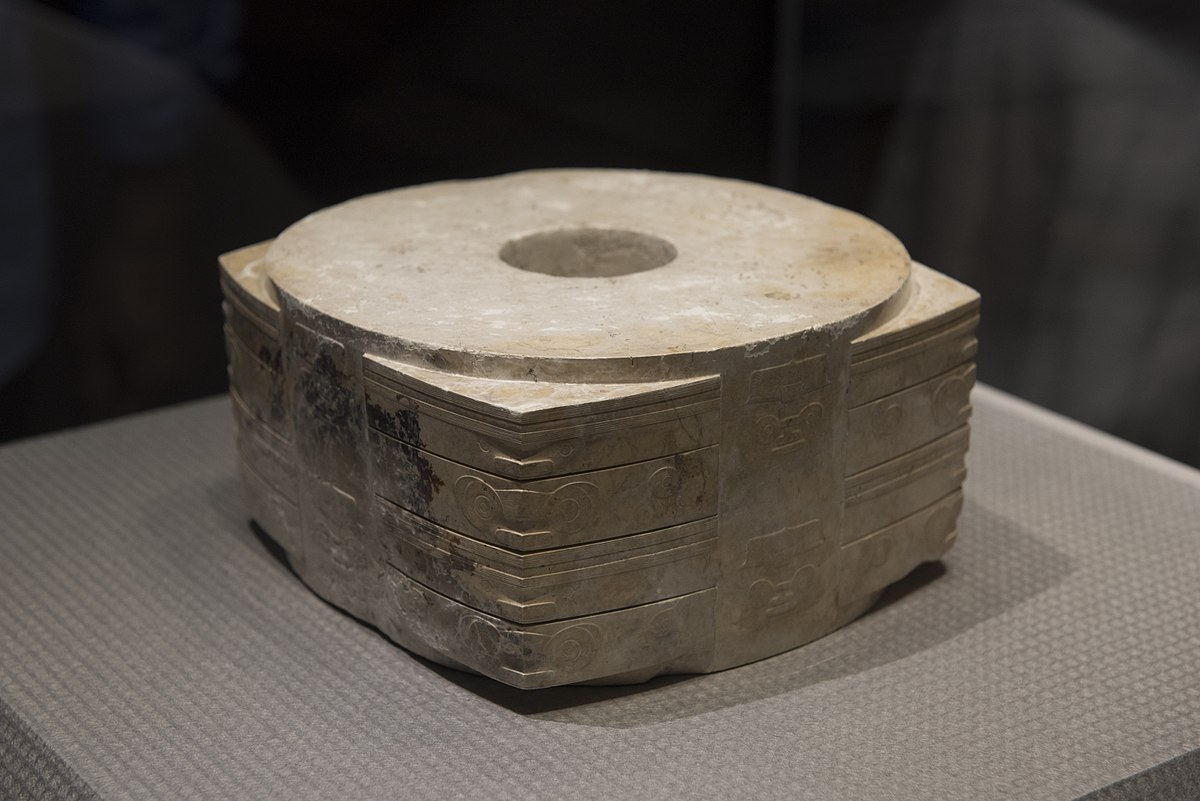
Stonehenge. Wiltshire, UK. Neolithic Europe. c. 2500-1600 BCE. Sandstone.
Form: made of bluestones and sarsen stones in post and lintel (two posts support a horizontal beam)
-Henge: neolithic monument characterized by a circular ground plan which is believed to be used for ritual and marking astronomical events
-Mesolith: an uncut stone of great size
-aligns with the winter solstice
-Mortise/tenon: groove is cut into stone/wood that is shaped to receive a projection (tenon)- (kinda like a puzzle)
-Don’t know how it was moved, but the large stones are from Southern England
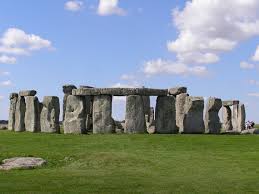
The Ambum Stone. Ambum Valley, Enga Province, Papua New Guinea. c. 1500 BCE. Greywacke.
Form: 8 inch, fits in palm of hand, exaggerated belly, round bottom, geometric eyes, stylized
Content: composite: an animal w human elements, vice versa (anteater like), less detailed feet, supernatural :may have been an object that connected to ancestors (possessed their spirit), arms that end w human-like fingers, phallic nose (fertility)
Context: the oldest found, taken sculptor months, found in the same pt of the island. Neolithic, but still rely on hunting.
Function: private/personal use, ritual (multiple) maybe crushing herbs for pigment
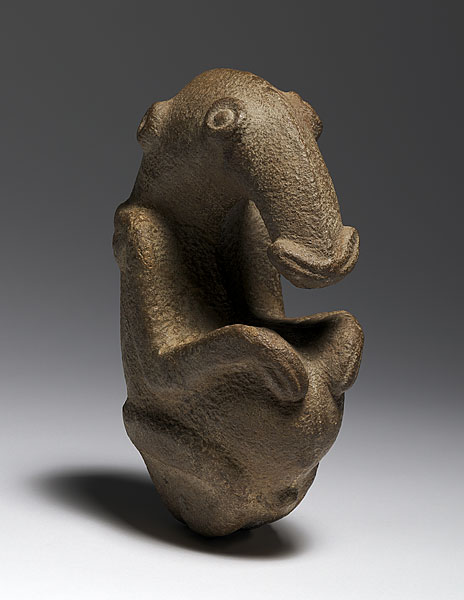
Tlatilco Female Figurine. Central Mexico, site of Tlatilco. 1200-900 BCE. Ceramic.
Form: women’s figure (breasts, larger hips).Very small and can’t stand up so may be more personal/individual.
Content: could be related to womens’ fertility from the exaggerated figure, and the double face suggests the value of duality to its ppl. Suggests supernatural belief: horns
Context: hand-sculpted during NEOLITHIC age bc more stylized, and doesn’t have an obvious use (like for hunting). Found near burials and dwellings suggesting importance of the afterlife.
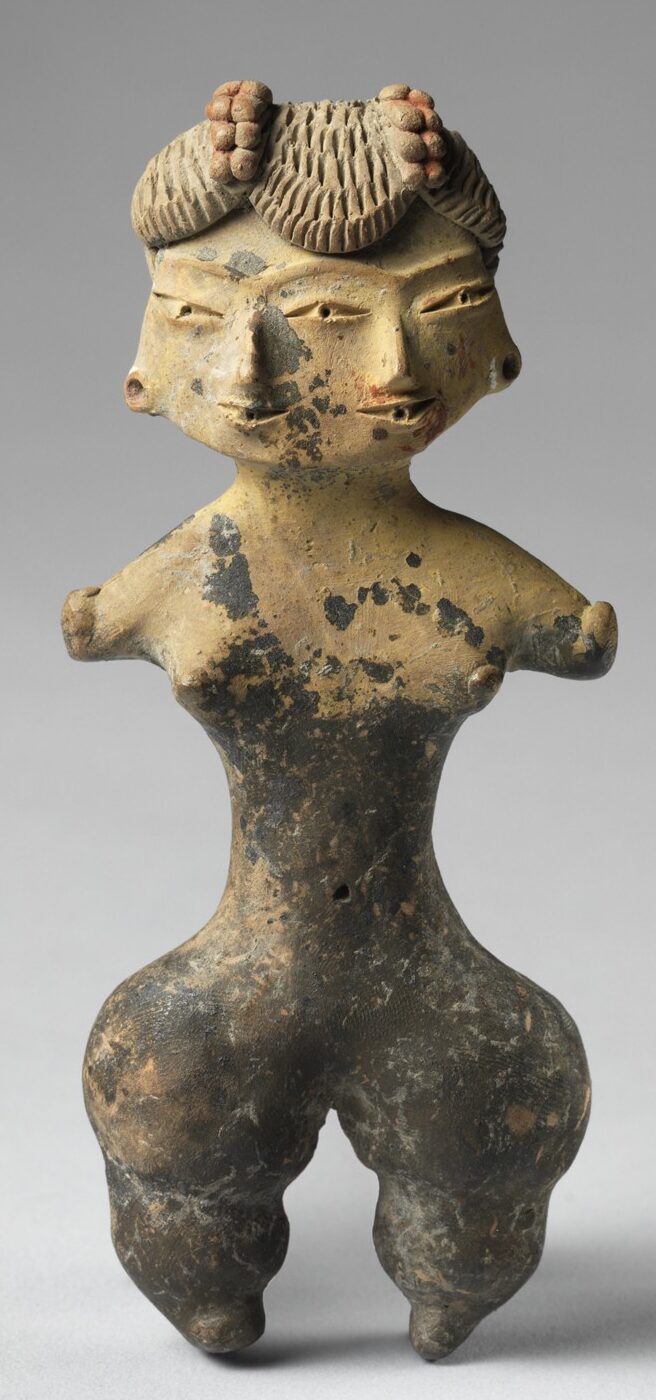
Anthropomorphic Stele. Arabian Peninsula. Fourth millennium BCE. Sandstone.
Form: believed to be male bc no female parts, may be warrior/hunter
-bottom could be male genital/sword ]. Not very stylized. Straps could represent a scabbard or hold a weapon.
Context: Neolithic era bc of how straight/smooth it is
Function: used as a grave marker (stele) and spread out between tribes. May have been used near a warrior’s burial. May be above the ground and used to signify the deceased person.
Anthropomorphic: human form/attributes
![<p><strong>Form: </strong>believed to be male bc no female parts, may be warrior/hunter</p><p>-bottom could be male genital/sword ]. Not very stylized. Straps could represent a scabbard or hold a weapon. </p><p></p><p><strong>Context: </strong>Neolithic era bc of how straight/smooth it is </p><p></p><p><strong>Function: </strong>used as a grave marker (stele) and spread out between tribes. May have been used near a warrior’s burial. May be above the ground and used to signify the deceased person. </p><p></p><p><strong>Anthropomorphic: </strong>human form/attributes</p>](https://knowt-user-attachments.s3.amazonaws.com/722bda08-f6db-4c3a-bd49-b427ec37e7b7.jpg)
Camelid sacrum in the shape of a canine. Tequixquiac, central Mexico. 14000-7000 BCE. Bone.
No function, don’t know where it was found.
Sacrum: a large triangular bone at the base of the spine (sacred) and represents resurrection
Content: believed to represent a canine
Context: hunters → use canines ; gatherers → use dogs. PALEOLITHIC. Palm-sized
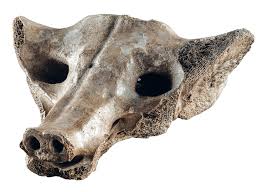
Terra cotta fragment. Incised terra cotta. Lapita, Reef Islands, Solomon Islands. 1000 BCE.
Form: entire piece is a reddish-brown color. A stylized human face dominates the art: somewhat stylized/distorted. Details are stamped out and repeated through the image (ribbon like/circles) . There are many geometric patterns and you can’t tell the gender but tools are used for the patterns
Context: neolithic bc the lapita ppl were settled near the coast and could have used the art for ceramics (cooking/storing food)
Content: some of the designs may be related to patterns seen in modern Polynesian tattoos/barkcloth
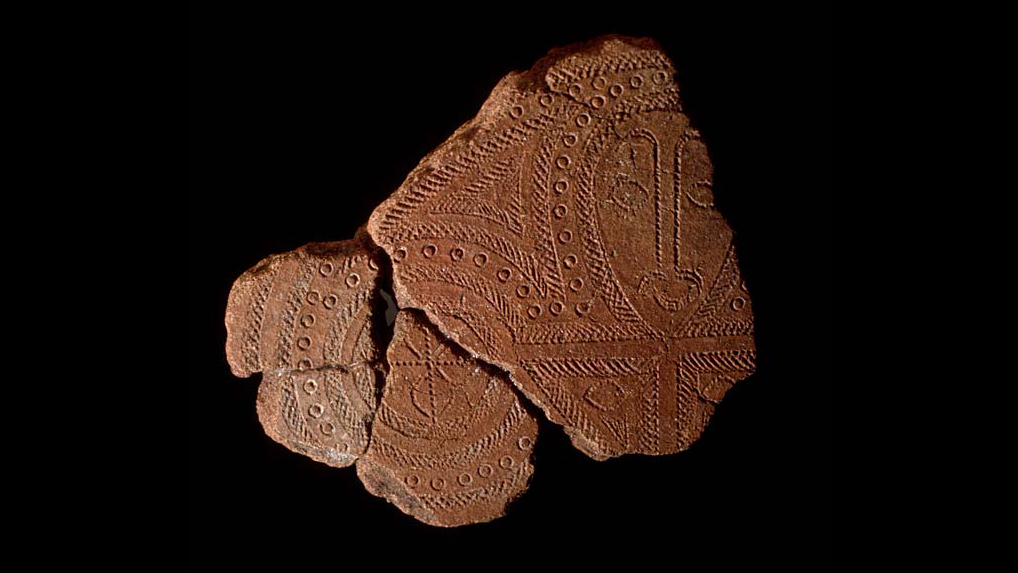
Stylized
Deviating from realistic where the figure is abstracted from the way it appears in nature. Common to the neolithic prd.
Apollo 11 stones. Namibia. c. 25,500-25,300 BCE. Charcoal on Stone.
Form: on the cleavage there is a face of a once complete rock, there is an unidentified animal form resembling a feline with human hind legs, 2 slightly curved horns, and a bovid organ on the underbelly
Content: may suggest Shamanist beliefs (supernatural creature) and offers evidence the Homo sapiens in the Middle Stage was behaviorally modern (symbolic thought)
Function: may have been observed/imagined and presents human cognition
Context: possibly shamanist religion (spiritual world and real world connected through individuals who can connect w it) and found buried in a cave from somewhere else. Paleolithic.
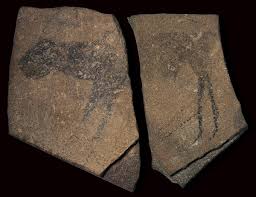
Great Hall of the Bulls. Lascaux, France. Paleolithic.
Context: located among many other cave paintings and very common to Paleolithic Europe. All animal themed and ppl used holes/planks to lift themselves to paint the roof.
-Very far into the cave and no natural light source (artificial illumination was used) May not be open to all bc it’s so secluded (might have ceremonial function)
-Paintings highly important to the ppl, who were hunter-gatherers=cave art.
Form: HUGE animals. NOT a hunting scene but shows 3 important animals to Lascaux. Over 600 animals overlap and many artists over many generations. Naturalized.
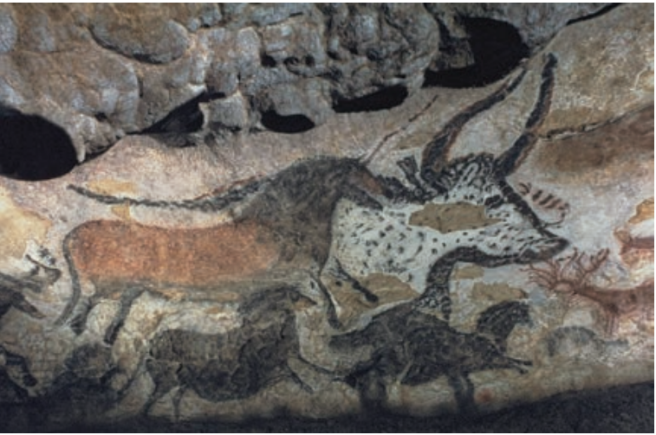
Beaker with Ibex Motifs. Painted Terra cotta. Susa, Iran. 4200-3500 BCE.
Context: Neolithic. Animals are domesticated, there is pottery (farming) and animals are contained (not running as much)
Form: stylized. At the top is the ibex, then dogs in the middle, and goat the bottom
Function: NOT used for domestication purposes bc too thin, no grain, etc,…
-Burial purpose but no physical purpose. Shows belief in afterlife/supernatural elements
